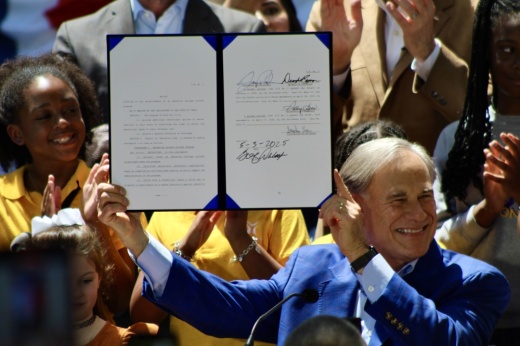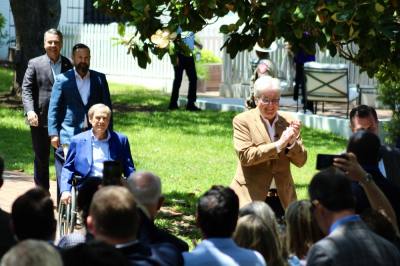Speaking to over 1,000 attendees in front of the governor’s mansion, Abbott said he was signing “the largest day-one school choice program in the United States.” The program will launch at the beginning of the 2026-27 school year.
“Gone are the days that families are limited to only the school assigned to them by [the] government,” Abbott said. “Today has arrived and empowers parents to choose the school that is best for their child.”
The overview
SB 2 will set aside $1 billion for education savings accounts, which families can use to pay for private school tuition and other educational expenses, such as textbooks or transportation. Most participating students will receive 85% of the per-student funding public schools get from state and local sources—about $10,330 in the first year of the program, according to estimates from the nonpartisan Legislative Budget Board. Texas Education Agency data shows the average Texas public school received $12,815 per student in state and local funds during the 2022-23 school year.
Students with disabilities will qualify for up to $30,000 per year under SB 2, while families who homeschool their children can receive up to $2,000 annually. Rather than giving families direct access to the ESA funds, the state comptroller will distribute money to private schools or other vendors, such as tutors. Lawmakers have said this will prevent potential fraudulent spending.
Abbott said an education savings account program is key to “[putting] our children on a pathway to having the No. 1-ranked education system in the United States of America.” Legislative leaders have also vowed to raise teacher salaries and public school funding in tandem with the ESA package, although school finance bills have stalled with 30 days remaining in the regular legislative session.
“We are going to make, through school choice, public schools even more competitive and better,” Lt. Gov. Dan Patrick said during the May 3 event. “It's not about us against them or them against us—all together, we want the best public school system, the highest-paid teachers and the best school choice program in the world.”

Funding for the ESA program is capped at $1 billion for the 2026-27 biennium. The Legislative Budget Board estimated demand for the program would reach $4.8 billion by 2030, although it will be up to state lawmakers to raise or cut funding in future years.
If applications for the program outpace available funding, SB 2 will first prioritize students with disabilities whose annual household incomes are at or below 500% of the federal poverty line—about $160,000 for a family of four, according to the U.S. Department of Health and Human Services. Next in line are families with incomes at or below 200% of the FPL, which is about $64,000 for a family of four. Families with incomes between 200-500% of federal poverty guidelines will be in the third priority tier, followed by all families, regardless of income.
Under the ESA program, private schools will not be required to accept all students or comply with federal laws that ensure public schools provide services tailored to students’ needs, lawmakers said.
Any Texas school-age children who are U.S. citizens or lawful residents will be eligible to apply for an ESA. If a child is accepted into the program, any of their eligible siblings who applied during the same application cycle must also be accepted, according to a breakdown of the bill.
Private schools must be accredited and operate in Texas for at least two years before they can accept ESA students, bill author Sen. Brandon Creighton, R-Conroe, said before senators approved House amendments to SB 2 on April 24. Third through 12th grade students participating in the ESA program will be required to take a nationally norm-referenced exam or the State of Texas Assessments of Academic Readiness each year.
More context
Some opponents of education savings accounts have expressed concerns that the program will divert funding from public school districts facing financial challenges and unfairly benefit wealthy families.
“I have a message to the working family communities in Texas: vouchers are a scam intended to benefit rich people,” Rep. Ana-María Rodríguez Ramos, D-Richardson, said during a marathon House session April 16. “These private schools are not required to accept your children. You give up the rights you had in public schools. The full cost of tuition, transportation and textbooks will almost never be covered fully by the voucher.”
During the 2023-24 school year, the average cost of Texas private school tuition was $10,965 for kindergarten-eighth grade students and $14,986 for high school students, according to the Texas Private Schools Association.
Rep. Brad Buckley, R-Salado, who sponsored SB 2 in the House, told his colleagues he did not think public schools in other states had been harmed by ESAs or related programs.
“When you are providing services and you're meeting the needs of children, we know that [many] parents will stay in their public school,” Buckley said April 16. “I do know that this opportunity that we will provide will not hurt our public schools. It'll just create another lane or another option for parents.”
Legislative budget analysts wrote that public schools “may experience a decrease in... funding as a result of the bill due to students leaving public schools to participate in the ESA program.”
Proponents of SB 2 have said the program will expand educational options for families who may not want to send their children to a public school.
“The single parent working two jobs, unable to move their child to a school where they feel safe—they’ll have an opportunity to not be trapped by ZIP code,” Creighton said April 24. “Passing this bill sends a message to all of Texas. It tells the next generation of Texas leaders: your path should fit your purpose, your path should fit what’s best for you and your family, and your ambition will always be greater than any system or any institution.”

“This bill is only best for the richest people in the state, and rural Texas especially will get the shaft,” Scudder said. “To top it all off, Abbott’s school shut-downs are in full-swing with no end in sight. Texas Democrats will keep fighting for public schools and make sure voters don’t forget this in 2026.”
How we got here
During previous legislative sessions, some Republicans from rural communities joined House Democrats to repeatedly shoot down ESA bills. Following the 2023 session, the lower chamber shifted further to the right when several pro-ESA Republicans ousted incumbents and two seats previously held by Democrats flipped to Republicans.
SB 2 was the first bill state senators passed this year, after Abbott deemed education savings accounts an emergency legislative priority.
“The Bible says, on the seventh day, he rested. We passed school choice in the Senate six times—now, we rest,” Patrick said during a March 25 news conference about education savings accounts.
House lawmakers debated SB 2 for over 10 hours on April 16-17 before approving the legislation with an 85-63 vote. The Senate signed off on House changes to the bill on April 24.







